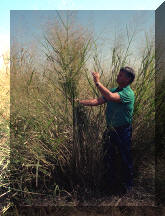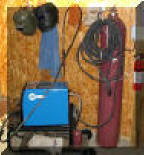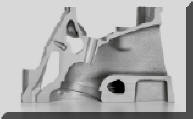|
Can Ethanol Replace Gasoline?
In a Word Yes, But Possibly Made From Switchgrass!
Ethanol can
replace at least some of gasoline which is derived from oil. In fact in Brazil
after the 1973 oil crisis (and where the World doesn’t allow them just to
print money to pay for oil as they have with the US)
they went on an aggressive Ethanol program. Now they only sell E20 and E25
(20% and 25% Ethanol Gasoline mixtures) and 100% Ethanol for cars they refer
to as flex-fuel vehicles that can run on E100. About 40% of their fuel
for cars and other light vehicles is Ethanol made from sugar cane! |
|
Indy
Race Cars
have run on alcohol for years. They are
switching to pure, renewable Ethanol versus the mixture of Ethanol and
methanol. Methanol is produced from methane in natural gas or it can be
made from coal. Drag Racers have some classes that allow the use of
Ethanol. Actually races use 98% Ethanol mixed with 2% Gasoline - so you can’t
drink it!
NASCAR
Announced it will use E15 (15% Ethanol in gasoline) for the 2011 season. |
|
What’s Wrong With Using Ethanol?
Using
Ethanol will reduce the demand for gasoline where
oil producing countries have a stranglehold on amount of supply! Some misconceptions exist often
promulgated by elitists who fly around in their corporate jets giving
lectures on how we should ride bicycles! Here are some: |
|
There is Not Enough Corn:
In 2007
there was a surplus of 1.8 billion bushels of corn (the amount in excess
after all needs are met!) The American Farmer has a history of increasing
productivity when called to do so. Even purists shouldn’t care about
genetically altered corn being made into fuel! The corn used to make
Ethanol is not the sweet corn we eat. Much of it is used for animal
feed and after making Ethanol there is still a significant residual left and
sold for that purpose. That part of the corn that is used to make
Ethanol is the starchy product that goes to make corn syrup! We could all probably use less of that product in our
food!
 In
many parts of the country (like were I live in South Carolina) they can’t
economically grow corn but we can easily grow and harvest switchgrass (Photo
Left!)
There is some excellent research directed at improving the processes of making
Ethanol from this natural North American prairie grass! We could no
doubt spend more on this R&D effort. Because it is
native, switchgrass is resistant to many pests and plant diseases, and it is
capable of producing high yields with very low applications of fertilizer.
This means that the need for agricultural chemicals to grow switchgrass is
relatively low. Switchgrass is also very tolerant of poor soils, flooding
and drought, which are widespread agricultural problems in the southeast
(and other places.) We are very fortunate to have a lot of unused land in
the country that can grow this natural product. In
many parts of the country (like were I live in South Carolina) they can’t
economically grow corn but we can easily grow and harvest switchgrass (Photo
Left!)
There is some excellent research directed at improving the processes of making
Ethanol from this natural North American prairie grass! We could no
doubt spend more on this R&D effort. Because it is
native, switchgrass is resistant to many pests and plant diseases, and it is
capable of producing high yields with very low applications of fertilizer.
This means that the need for agricultural chemicals to grow switchgrass is
relatively low. Switchgrass is also very tolerant of poor soils, flooding
and drought, which are widespread agricultural problems in the southeast
(and other places.) We are very fortunate to have a lot of unused land in
the country that can grow this natural product. |
|
Ethanol is Bad for Your Car and the Environment:
An
Ethanol mixture of 10% is approved for all cars. In fact it increases
octane level 2 to 3 points without adding toxic chemicals. Ethanol adds
oxygen to the fuel and if we were to achieve the 15 billion gallon federal
target we would reduce greenhouses gases 20%! How can that be.
Simple, an Ethanol molecule has 2 Carbon atoms, 6 Hydrogen atom and 1 Oxygen
atom. By weight that's 35% Oxygen! Gasoline has none. So
California had them add
methyl tertiary butyl ether, MTBE to their gasoline to reduce emissions
until they found it polluted the ground!! MTBE only has 18% Oxygen.
Isn't it better to add Ethanol! |
|
Ethanol Has Less Energy Than Gasoline- You'll
Use More:
That is
true, it has less energy per pound but it also has much higher octane so the
engine can be adjusted to produce more power! Or a smaller engine can
be used to produce the same power and a smaller engine means a lighter car
etc. Let's explain:
-
Ethanol
has 13,000 BTU's/lb (a measure of energy). It also has a 113 octane
rating (R+M)/2
-
Pump
Gasoline has 18,500 BTU's/lb and 87 to 93 octane rating
-
E85
has 14,000 BTU's/lb and 105 octane rating
-
E10
has 17,000 BTU's/lb and 90 to 93 octane rating
(Note:
In a test by Edmonds, the car folks, showed in a trip in a Chevy Tahoe
from San Diego to Los Vegas Gasoline achieved 18.3 mpg while E85 achieved
only 13.5 mpg 26% less mileage.
)
Now if we
went all the way to E85 (the 15% gasoline helps starting etc) we'd have an octane rating like racing gasoline!
The Otto cycle gets more efficient the higher the compression ratio
(Nicholas Otto was granted a patent in 1876 for the 4 stroke engine
design used in our cars.)
NASCAR
engines are mandated to a maximum of 12:1 compression in their carbureted
naturally aspirated engines. They generate about 775 hp with 358 cid.
That's 2.15 hp/cubic inch of displacement. If we only need 200 hp can
we get by with an efficient 95 cubic inch (1.5 L) engine!
Richard Petty was quoted in a Circle Track article saying NASCAR had to
mandate 12:1 a few years ago because some builders were going as high as
18:1! With 105 octane we could probably use 14:1!
An MIT
research group is developing a small turbocharged engine that uses 19:1
compression which they indicate gets the efficiency of a diesel. In
essence they regain all the lost power per pound of fuel through efficiency!
Check out how much of the gasoline we
use wasted in a standard engine.
Direct
injection being used in a number of gasoline engines provides more control
of flame propagation. Now if we
just added a turbo to a 12:1 compression 1.5 L engine and a sensor to
control boost depending what % Ethanol was being used we'd have a great
flex-fuel engine!
The
challenge and opportunity are there for inventive "Hot Rodders" to
show what can be done! |
|
NO VESTED INTEREST:
Having no financial
interest in a farm or corn, sugar cane or switchgrass production it just makes sense to have the
ability to control
our destiny and be able to leverage the price of oil with Ethanol!
Having
worked with the heavy fabrication industry through most of my career, my
personal preference is for electric cars recharged at night by nuclear
power, wind power, hydropower and geothermal; all of which must run anyway!
This leaves the peak daytime electric power needs to be supplemented with
fossil fuel (or switchgrass) sources and if we every can make enough economically - solar
power. In fact some plants are now burning
switchgrass as a fuel. No conversion needed just drying!
But while
we take years to build the nuclear power plants we should have been building
in the past 25 years Ethanol is probably a good step forward! |
|
Only About 13% of the
Energy in Gasoline Gets to the Wheels to Power the Car!
Where Does It All Go?
CLICK |
|
Want Some Ideas
on How to Save 20% or More Gasoline?
CLICK |
|
. |
|
Have a Welder? You Can Save a Higher
Percentage of MIG Shielding Gas Than You Can Gasoline with Our
Patented Gas Saver System (GSS)!!
You'll Also Improve Weld Starts and
Have a Shielding Gas Cylinder Last at Least Twice as Long!
Note: Our Patented
GSS
is Not Available in "Stores"

A home shop fabricator
in Georgia with a MillerTM 175 amp welder
purchased a 50 foot Gas Saver System ( GSSTM
) so he could use a larger cylinder
and mount it on the wall of his shop. He wrote:
"The system works great.
Thanks for the professional service and
a great product."
Click To See His Home Shop
A Professional
Street Rod Builder Had This to Say:
With their standard MIG welder gas delivery hose the
peak shielding flow at weld start was measured at 150 CFH. That caused air
to be sucked into the gas stream causing poor weld starts. With the GSS replacing their existing
hose, the peak flow surge at the weld start was about 50 CFH. Total gas use
was cut in half.
Kyle Bond, President, quickly saw the improvement
achieved in weld start quality as a significant advantage! Kyle, an
excellent automotive painter, was well aware of the effects of gas surge
caused by pressure buildup in the delivery hose when stopped. He has to
deal with the visible effects in the air hose lines on the spray gun in his
paint booth! The paint surge is visible and creates defects unless the gun
is triggered off the part being painted! We can’t do that with our MIG gun!
|
|

MIG Gas Delivery and the Small Block Chevy
Evolved in a Similar Way and Time!
Both had Advances and
Setbacks Before
They Were Optimized!
Click
for a PDF Report on the Similarities |
|
Purchase Products |

Purchase Gas Saving Products |

Purchase Training Aids |

Purchase
Flow Rate Limiter |

Purchase Wire Feeding Aids |